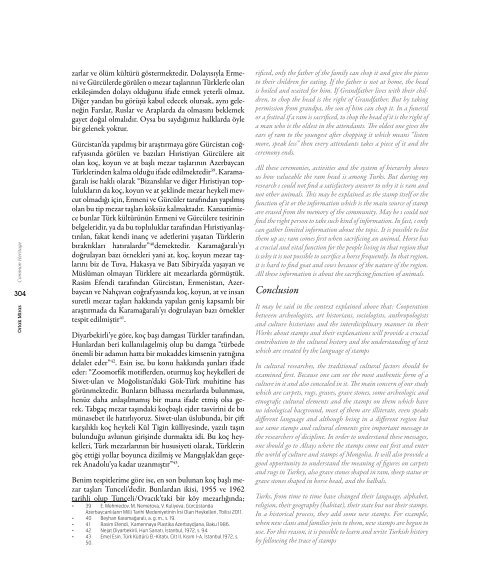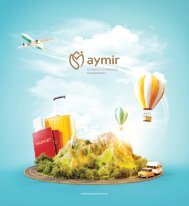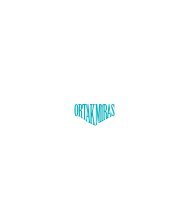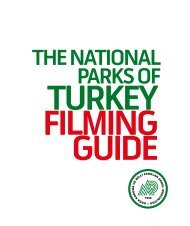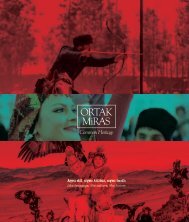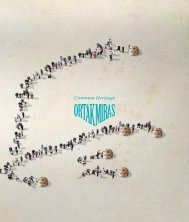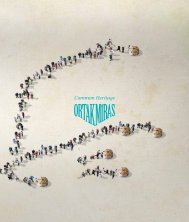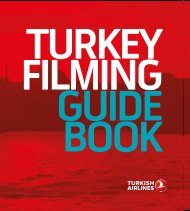You also want an ePaper? Increase the reach of your titles
YUMPU automatically turns print PDFs into web optimized ePapers that Google loves.
Common Heritage<br />
304<br />
Ortak Miras<br />
zarlar ve ölüm kültürü göstermektedir. Dolayısıyla Ermeni<br />
ve Gürcülerde görülen o mezar taşlarının Türklerle olan<br />
etkileşimden dolayı olduğunu ifade etmek yeterli olmaz.<br />
Diğer yandan bu görüşü kabul edecek olursak, aynı geleneğin<br />
Farslar, Ruslar ve Araplarda da olmasını beklemek<br />
gayet doğal olmalıdır. Oysa bu saydığımız halklarda öyle<br />
bir gelenek yoktur.<br />
Gürcistan’da yapılmış bir araştırmaya göre Gürcistan coğrafyasında<br />
görülen ve bazıları Hıristiyan Gürcülere ait<br />
olan koç, koyun ve at başlı mezar taşlarının Azerbaycan<br />
Türklerinden kalma olduğu ifade edilmektedir 39 . Karamağaralı<br />
ise haklı olarak “Bizanslılar ve diğer Hıristiyan toplulukların<br />
da koç, koyun ve at şeklinde mezar heykeli mevcut<br />
olmadığı için, Ermeni ve Gürcüler tarafından yapılmış<br />
olan bu tip mezar taşları köksüz kalmaktadır. Kanaatimizce<br />
bunlar Türk kültürünün Ermeni ve Gürcülere tesirinin<br />
belgeleridir, ya da bu topluluklar tarafından Hıristiyanlaştırılan,<br />
fakat kendi inanç ve adetlerini yaşatan Türklerin<br />
bıraktıkları hatıralardır” 40 demektedir. Karamağaralı’yı<br />
doğrulayan bazı örnekleri yani at, koç, koyun mezar taşlarını<br />
biz de Tuva, Hakasya ve Batı Sibirya’da yaşayan ve<br />
Müslüman olmayan Türklere ait mezarlarda görmüştük.<br />
Rasim Efendi tarafından Gürcistan, Ermenistan, Azerbaycan<br />
ve Nahçıvan coğrafyasında koç, koyun, at ve insan<br />
suretli mezar taşları hakkında yapılan geniş kapsamlı bir<br />
araştırmada da Karamağaralı’yı doğrulayan bazı örnekler<br />
tespit edilmiştir 41 .<br />
Diyarbekirli’ye göre, koç başı damgası Türkler tarafından,<br />
Hunlardan beri kullanılagelmiş olup bu damga “türbede<br />
önemli bir adamın hatta bir mukaddes kimsenin yattığına<br />
delalet eder” 42 . Esin ise, bu konu hakkında şunları ifade<br />
eder: “Zoomorfik motiflerden, oturmuş koç heykelleri de<br />
Siwet-ulan ve Moğolistan’daki Gök-Türk muhitine has<br />
görünmektedir. Bunların bilhassa mezarlarda bulunması,<br />
henüz daha anlaşılmamış bir mana ifade etmiş olsa gerek.<br />
Tabgaç mezar taşındaki koçbaşlı ejder tasvirini de bu<br />
münasebet ile hatırlıyoruz. Siwet-ulan üslubunda, bir çift<br />
karşılıklı koç heykeli Kül Tigin külliyesinde, yazılı taşın<br />
bulunduğu avlunun girişinde durmakta idi. Bu koç heykelleri,<br />
Türk mezarlarının bir hususiyeti olarak, Türklerin<br />
göç ettiği yollar boyunca dizilmiş ve Mangışlak’dan geçerek<br />
Anadolu’ya kadar uzanmıştır” 43 .<br />
Benim tespitlerime göre ise, en son bulunan koç başlı mezar<br />
taşları Tunceli’dedir. Bunlardan ikisi, 1955 ve 1962<br />
tarihli olup Tunceli/Ovacık’taki bir köy mezarlığında;<br />
• 39 E. Mehmedov, M. Nemetova, V. Kuliyeva, Gürcüstanda<br />
Azerbaycanlıların Milli Tarihi Medeniyetinin İrsi Olan Heykelleri, Tbilisi 2011.<br />
• 40 Beyhan Karamağaralı, a. g. m., s. 19.<br />
• 41 Rasim Efendi, Kamennaya Plastika Azerbaydjana, Baku 1986.<br />
• 42 Nejat Diyarbekirli, Hun Sanatı, İstanbul, 1972, s. 94.<br />
• 43 Emel Esin, Türk Kültürü El-Kitabı, Cilt II, Kısım I-A, İstanbul 1972, s.<br />
50.<br />
rificed, only the father of the family can chop it and give the pieces<br />
to their children for eating. İf the father is not at home, the head<br />
is boiled and waited for him. İf Grandfather lives with their children,<br />
to chop the head is the right of Grandfather. But by taking<br />
permission from grandpa, the son of him can chop it. In a funeral<br />
or a festival if a ram is sacrificed, to chop the head of it is the right of<br />
a man who is the oldest in the attendants. The oldest one gives the<br />
ears of ram to the youngest after chopping it which means “listen<br />
more, speak less” then every attendants takes a piece of it and the<br />
ceremony ends.<br />
All these ceremonies, activities and the system of hierarchy shows<br />
us how valueable the ram head is among Turks. But during my<br />
research ı could not find a satisfactory answer to why it is ram and<br />
not other animals. This may be explained as the stamp itself or the<br />
function of it or the information which is the main source of stamp<br />
are erased from the memory of the community. May be ı could not<br />
find the right person to take such kind of information. In fact, ı only<br />
can gather limited information about the topic. It is possible to list<br />
them up as; ram comes first when sacrificing an animal. Horse has<br />
a crucial and vital function for the people living in that region that<br />
is why it is not possible to sacrifice a horse frequently. In that region,<br />
it is hard to find goat and cows because of the nature of the region.<br />
All these information is about the sacrificing function of animals.<br />
Conclusion<br />
It may be said in the context explained above that: Cooperation<br />
between archeologists, art historians, sociologists, anthropologists<br />
and culture historians and the interdiciplinary manner in their<br />
Works about stamps and their explanations will provide a crucial<br />
contribution to the cultural history and the understanding of text<br />
which are created by the language of stamps<br />
In cultural researches, the traditional cultural factors should be<br />
examined first. Because one can see the most authentic form of a<br />
culture in it and also concealed in it. The main concern of our study<br />
which are carpets, rugs, graves, grave stones, some archeologic and<br />
etnografic cultural elements and the stamps on them which have<br />
no ideological bacground, most of them are illiterate, even speaks<br />
different language and although being in a different region but<br />
use same stamps and cultural elements give important message to<br />
the researchers of dicipline. In order to understand these messages,<br />
one should go to Altays where the stamps come out first and enter<br />
the world of culture and stamps of Mongolia. It will also provide a<br />
good opportunity to understand the meaning of figures on carpets<br />
and rugs in Turkey, also grave stones shaped in ram, sheep statue or<br />
grave stones shaped in horse head, and the balbals.<br />
Turks, from time to time have changed their language, alphabet,<br />
religion, their geography (habitat), their state but not their stamps.<br />
In a historical process, they add some new stamps. For example,<br />
when new clans and families join to them, new stamps are begun to<br />
use. For this reason, it is possible to learn and write Turkish history<br />
by following the trace of stamps


